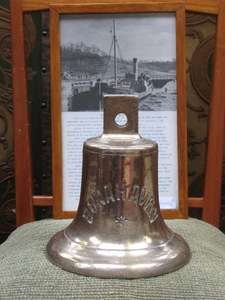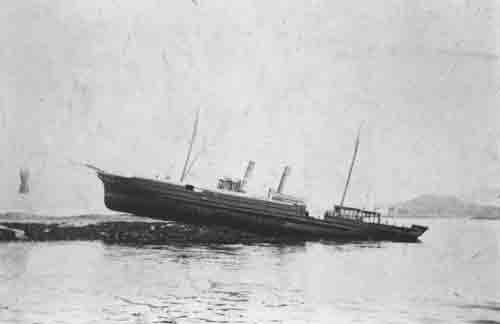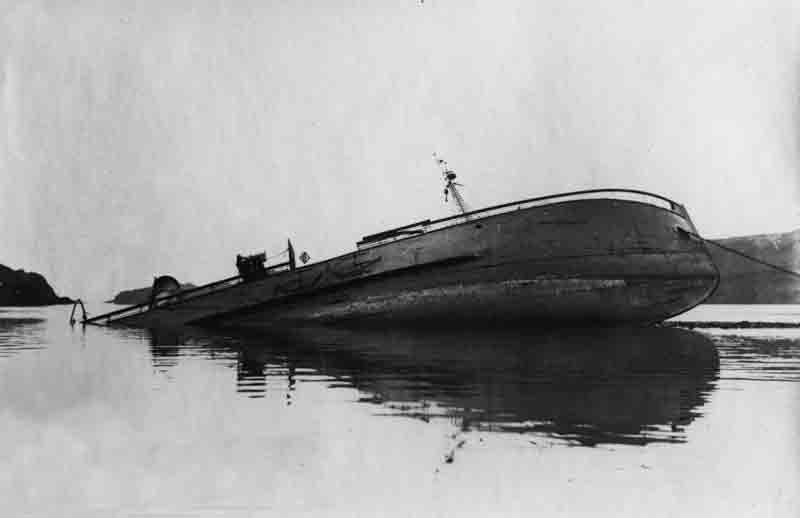The small steel steamship was launched from the yard of Scott and Sons in Bowling on 28th June 1900. She measured 117.0′ x 21.5′ x 9.4′ and weiaghed 227 gross tons, 85 net tons. Her twin cylinder compound vertically inverted steam engine by Muir and Houson of Glasgow delivered 35 rhp. Built as the Bonahaven was built for her first owners Paton and Hendry of Glasgow but later sold to the Tay Sand Company and renamed Islandmagee. She was a single decked vessel with a raised quarter deck and rear engine used by her owners to transport sand between east coast ports.
She had made at least 150 voyages between Dundee and Leith with only a limited number of trips on other routes although she did manage a few to the North Sea ports of continental Europe. The requirements for ships loading, unloading and transporting sand are fairly unique as the sank can often be wet when loaded resulting in additional weight and essential drainage of the water as it settles from the soaking cargo. It appears that the Islandmagee was well suited to her trade with hundreds of successful voyages throughout her career and a well documented continual maintenance programme by her owners ensured she remained so.
On 26th October 1953 the Islandmagee was loaded with a normal cargo of 200 tons of sand at Birkhill, River Tay and set off, bound for Leith, late that afternoon between 17:00 and 18:00 despite warnings of gale force winds on the BBC shipping forecast. On the bridge skipper Robert Ross was at the wheel and he had five crewmen aboard. As she passed Broughty Ferry the weather was deteriorating and later reported to be blowing Force 5 from the south south west but she continued to steam south and passed the North Carr Lightship at 21:15. By this time she was observed to be shipping some water but appeared in no serious difficulties. However the weather continued to worsen and , at 22:17 with winds now reported to be close to Force 9, distress flares were spotted by the coastguards at Fifeness from a position which appeared only two or three miles south of the lightship. The Anstruther and Arbroath lifeboats were quickly launched and headed for the area but no trace could be found of the ship in difficulties presumed to be the Islandmagee. The lifeboats eventually gave up the search and headed for home. Unfortunately the Arbroath lifeboat capsized as she reached her home port and all of the crew except one man were drowned.
A lifeboat from the Islandmagee was picked up 6 miles south east of Girdleness by the fishing vessel Dunottar on 30th October and four bodies were later washed ashore, three in the Tay estuary on 27th and 28th October and one in Lunan Bay on 8th December. No further trace of the ship was discovered.
The wreck of the Islandmagee was first located in a survey in 1960 and positively identified by recovery of the ship’s maker’s plate and bell in 1986. The wreck lies in position 56° 17.541’N, 002° 32.446’W (WGS84). The wreck lies on a rocky, sandy seabed in 35 metres with a least depth of 30 metres. She is oriented 065°/245° and sits upright fairly in tact with the large sand grab clearly visible on the starboard side of the deck. The stern superstructure remains reasonably in tact with companionways still visible although there is some deterioration on front side of the cabin. The area is subject fairly strong tidal flows so a slack water exploration is advised. However this exposure to current has resulted in a picturesque wreck covered in colourful sealife.






























